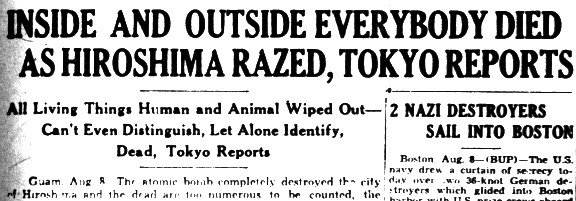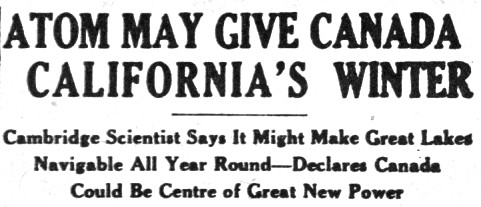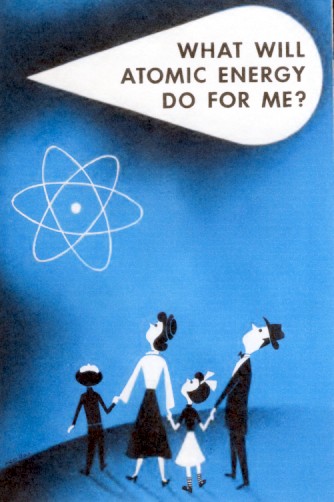Part 1
Hiroshima. PLUS our bright atomic future.
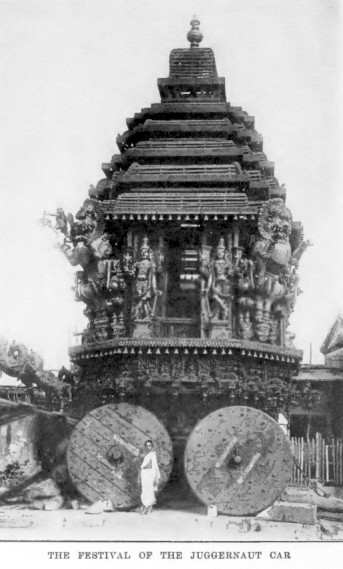
First the Bad News,
then the 'Good News'
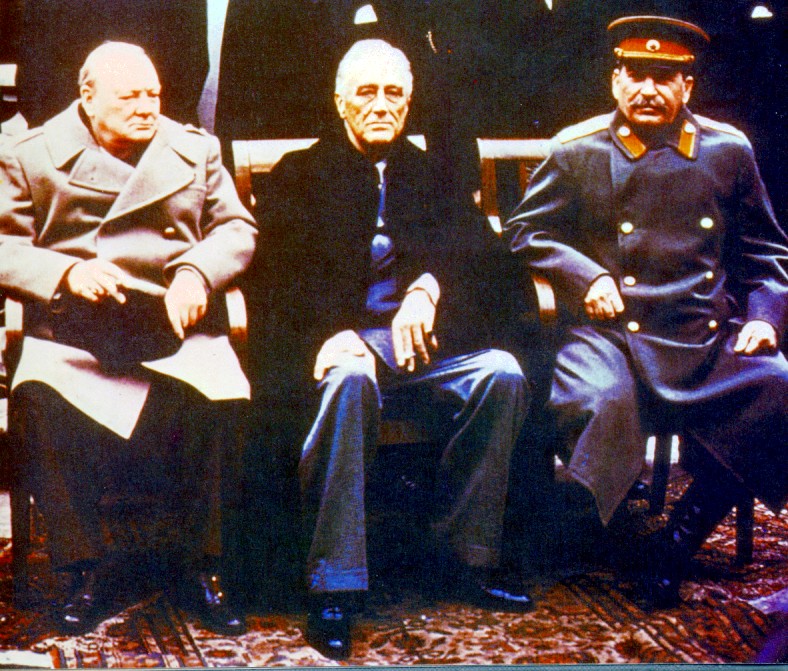
The Yalta Conference was held in Crimea in early February 1945.
At Yalta, Churchill, Roosevelt,
and Stalin - who looks content in spite of losing 20-30 million citizens, killed ...
discussed what would occur as, and after, World War 2 ended.
Roosevelt would be dead two months after the conference.
Churchill would be out of office in five months.
Truman, Roosevelt's vice president, would drop the first atomic bomb in six months ...
receiving a complete briefing on the weapon after Roosevelt's death and his own inauguration.
Stalin would have his first atomic test explosion in only four years.
Speaking of bombs, you can guess where this is ...
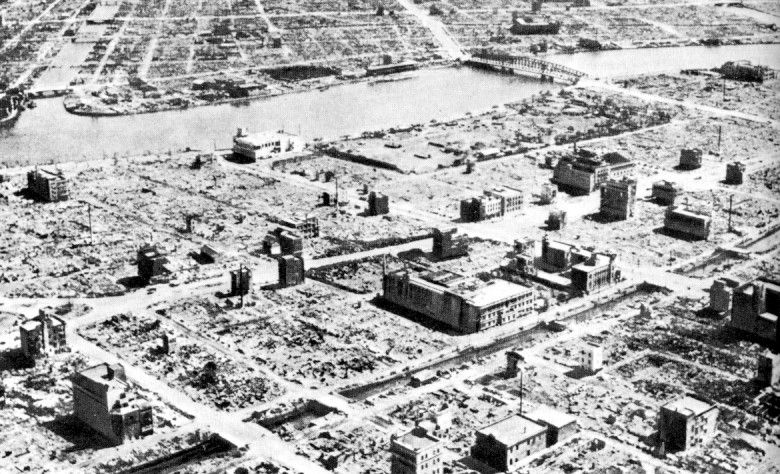
... Tokyo, early 1945
While photos of Hiroshima and the
terrible effects of the first of two atomic bombings are associated
with the
end of the war in the Pacific ... a more 'typical' activity of the this
period was the
fire bombing of Japanese cities ... whose civilian dwellings were
primarily of wood construction.
Some interesting facts about the Japanese campaign come from a documentary ... crafted around Robert S. McNamara's life experiences ... and his conclusions on war and the future of humanity ... "The Fog of War" (2003).
Targeting specific industrial installations by day in Europe ... against intense Flugabwehrkanone defences ... and Luftwaffe fighter pilots doggedly defending their homeland ... had taught the Americans plenty about bomber aircraft losses. For the first while, a new American bomber crew was (statistically) not destined to complete their tour of duty.
The Americans' new pressurized-cabin B-29 Superfortress bomber ... introduced late in the war ... was designed to fly safely above anti-aircraft fire and most enemy fighter planes, at over 30,000 feet. High altitude flying reduced the loss rate, but bombing accuracy was sacrificed.
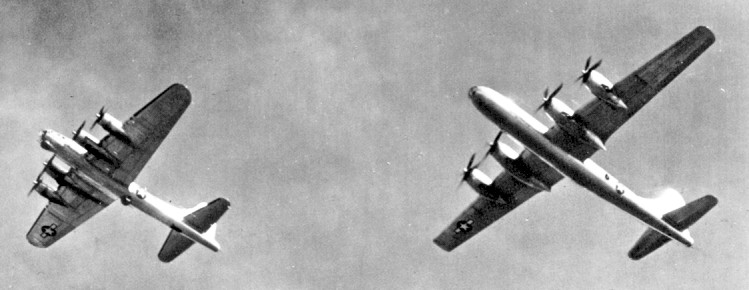
Left: The older B-17 Flying Fortress (introduced 1935) ... an important US bomber in Europe.
Right: The new B-29 Superfortress (introduced 1943) ... was directed to the Japanese bombing campaign.
Although they caught fire with some regularity, the B-29's engines had about twice the power of the B-17's.
Beginning in 1943, Captain Robert S. McNamara used his Harvard MBA to provide efficiency data and analysis to his US Army Air Force boss, Curtis LeMay. He thus contributed to LeMay's decision to strip his B-29's of most defensive weapons and extra weight ... so they could carry more incendiary bombs and fuel for his 'fire jobs' in Japan. Low altitude missions would improve bombing accuracy and were easier on the aircraft engines.
From the massive new air base on Tinian Island (shown below) to Japan - the aircraft flew about 3000 (statute) miles per mission, travelling at around 250 miles per hour.
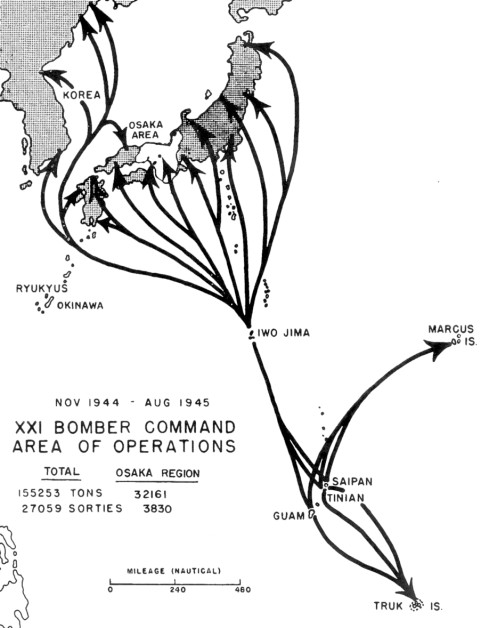
According to McNamara in "The Fog of War" ... incendiaries were dropped
over Japanese cities from an altitude of about 5000 ft. Here are some
statistics which attest to the destruction visited on particular
Japanese cities with the fire bombing campaign. For comparison, the
film juxtaposes American cities of about the same size to 'bring home'
the area of destruction and probable loss of life ...
In all, 67 Japanese cities suffered 50-90% destruction during the campaign.
On March 9-10, 1945 approximately 100,000 residents of Tokyo were killed in one night
by the firestorm started by a large incendiary raid ordered by LeMay.
(This was less than one month after the infamous 2-day raid on Dresden, Germany by the RAF and the USAAF)
After the war ended, the U.S. Strategic Bombing Survey meticulously analyzed the
newly acquired 'enemy' wartime economic and corporate statistics from the European and Pacific theatres ...
to determine the effectiveness of the strategic bombing campaigns in crippling Germany and Japan.
Some interesting facts about the Japanese campaign come from a documentary ... crafted around Robert S. McNamara's life experiences ... and his conclusions on war and the future of humanity ... "The Fog of War" (2003).
Targeting specific industrial installations by day in Europe ... against intense Flugabwehrkanone defences ... and Luftwaffe fighter pilots doggedly defending their homeland ... had taught the Americans plenty about bomber aircraft losses. For the first while, a new American bomber crew was (statistically) not destined to complete their tour of duty.
The Americans' new pressurized-cabin B-29 Superfortress bomber ... introduced late in the war ... was designed to fly safely above anti-aircraft fire and most enemy fighter planes, at over 30,000 feet. High altitude flying reduced the loss rate, but bombing accuracy was sacrificed.

Left: The older B-17 Flying Fortress (introduced 1935) ... an important US bomber in Europe.
Right: The new B-29 Superfortress (introduced 1943) ... was directed to the Japanese bombing campaign.
Although they caught fire with some regularity, the B-29's engines had about twice the power of the B-17's.
Beginning in 1943, Captain Robert S. McNamara used his Harvard MBA to provide efficiency data and analysis to his US Army Air Force boss, Curtis LeMay. He thus contributed to LeMay's decision to strip his B-29's of most defensive weapons and extra weight ... so they could carry more incendiary bombs and fuel for his 'fire jobs' in Japan. Low altitude missions would improve bombing accuracy and were easier on the aircraft engines.
From the massive new air base on Tinian Island (shown below) to Japan - the aircraft flew about 3000 (statute) miles per mission, travelling at around 250 miles per hour.

| Japanese
City |
Percentage
of city destroyed |
American
City (for comparison) |
| Yokohama |
58 % |
Cleveland |
| Tokyo |
51 % |
New York |
| Toyama |
99 % |
Chattanooga |
| Nagoya |
40 % |
Los
Angeles |
| Osaka |
35.1 % |
Chicago |
| Shimonoseki |
37.6 % |
San
Diego |
| Kure |
41.9 % |
Toledo |
| Kobe |
55.7 % |
Baltimore |
| Omuta |
35.9 % |
Miami |
| Wakayama |
50 % |
Salt
Lake City |
| Kawasaki |
36.2 % |
Portland |
| Okayama |
68.9 % |
Long
Beach |
| Kagoshima
|
63.4 % |
Richmond |
In all, 67 Japanese cities suffered 50-90% destruction during the campaign.
On March 9-10, 1945 approximately 100,000 residents of Tokyo were killed in one night
by the firestorm started by a large incendiary raid ordered by LeMay.
(This was less than one month after the infamous 2-day raid on Dresden, Germany by the RAF and the USAAF)
After the war ended, the U.S. Strategic Bombing Survey meticulously analyzed the
newly acquired 'enemy' wartime economic and corporate statistics from the European and Pacific theatres ...
to determine the effectiveness of the strategic bombing campaigns in crippling Germany and Japan.
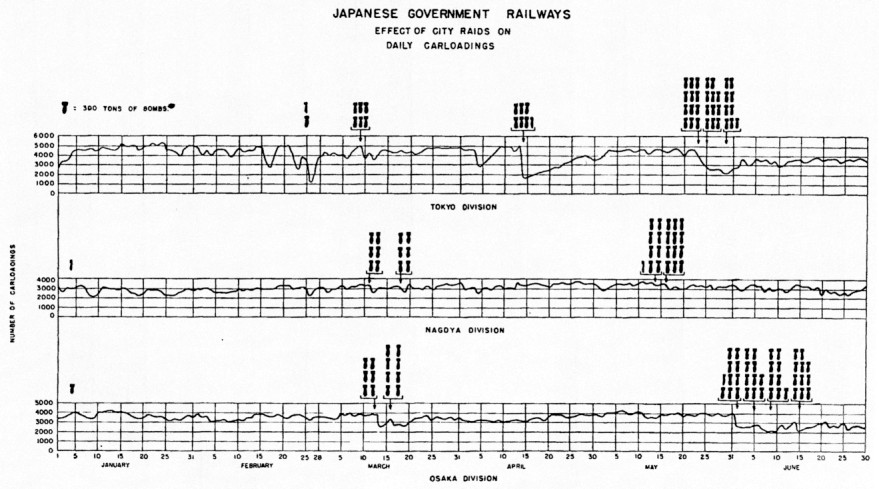
US Strategic Bombing Survey graph.
Each B-29 could carry about 10 tons of bombs.
The 'bomb symbols' on the graph each represent 300 tons.
Even the largest cluster of symbols here represents only about 60% ...
of the TNT-power of a single B-29 with a single atom bomb.
(assuming all the symbols represent high-explosive bombs ... not incendiaries)
Hiroshima and the Atomic Bomb
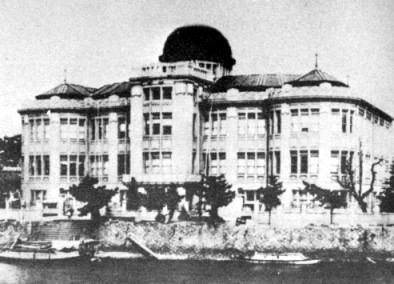
The now familiar 'Hiroshima Peace Memorial' before the bombing ...
when it was the Hiroshima Prefectural Industrial Promotion Hall.
The atomic bomb's fused airburst occurred 2000 feet above the dome.
The naked steel frame of the dome, and the ruins of the reinforced concrete structure are preserved today.
Its post bombing remains are shown at the white arrow below.
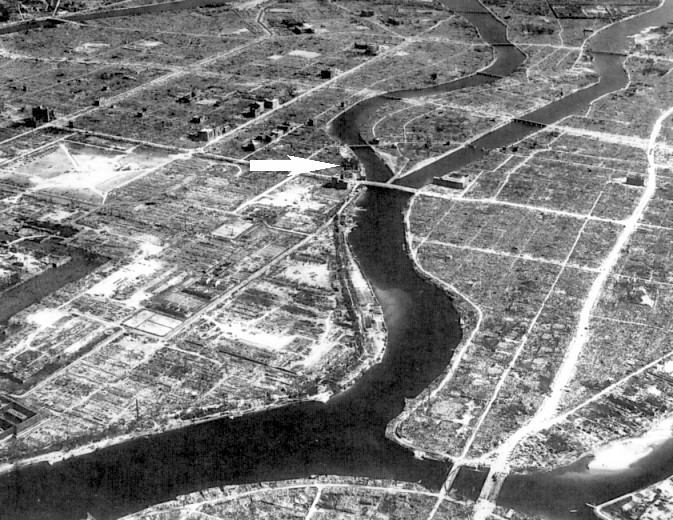
On August 6, 1945, Hiroshima's unique T-shaped Aioi Bridge was the aiming point,
which had been selected by the bombardier of the B-29 with the freshly-painted 'nose art' name 'Enola Gay'.
Bombing from an altitude of 6 miles, an easy-to-spot landmark was important to avoid error ...
on what was a symbolic, experimental, and 'necessary' mission.
The Enola Gay ... was named after the atomic bombing unit's Group Commander's mother -
he was the pilot that day ... having bumped the aircraft's usual 'atomic-trained' pilot for the critical mission.
The Group Commander wasn't pulling rank just to get 'the glory'.
There were many problems and failures with the second atomic bombing mission.
In light of this, he would have flown the third atomic bombing of Japan, himself - had it been ordered.
| "Only an alert and knowledgeable citizenry can compel the proper meshing of the huge industrial and military machinery of defense with our peaceful methods and goals, so that security and liberty may prosper together." Dwight D. Eisenhower, January 1961 |
A lot was riding on the first atomic bombing attempt in August 1945 ...
from the perspective of the few people who had some idea of what was about to happen.
Fewer people still ... knew exactly how many billions of dollars had been sunk to rush this secret project to completion ...
because of the fear that the (by now, defeated) Germans were working on a similar weapon.
At first ... it had been a concerted international scientific effort to stop the Germans from taking over the world.
After the project had developed its own military-industrial culture and momentum ... the bomb then sort of dropped itself ... twice.
The uranium bomb worked well at Hiroshima - never needing a test.
Then the Alamogordo-tested plutonium implosion bomb went to Nagasaki and it worked too.
In hindsight, the Strategic Bombing Survey later concluded Japan could not have continued past December 1945 even without atomic attacks.
It has often been claimed that the atomic bombing dispensed with the need for beach assaults on the Japanese homeland ...
which would have been very costly to both sides.
But ... if the atomic bomb resulted in a quicker Japanese surrender BEFORE the USSR moved into Japan from the north ...
you were killing two birds with one stone ! ... well ... so to speak.
Atomic bombs were obviously here to stay.
It would be easier to justify the sunk costs because the bombs had worked spectacularly ...
Had they not just forced the Japanese to surrender?
Some felt it might take the USSR ... TWENTY ... years to get their own A-bombs ... i.e. 1965.
"The United Nations" (aka 'The Allies') have harnessed the awesome power of the atom ... just think of the peacetime possibilities !
Pay no attention to that man behind the curtain !
... working on the American Hydrogen Bomb.
Articles from a Toronto Newspaper
August 8, 1945

This had happened on the morning of Monday, August 6 - at 0815hr Hiroshima time.
These stories appeared in the August 8 edition of this evening paper.
